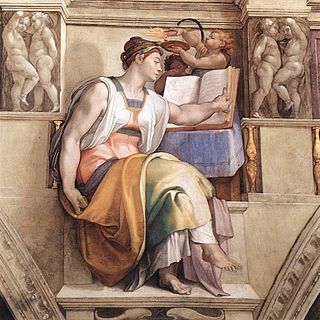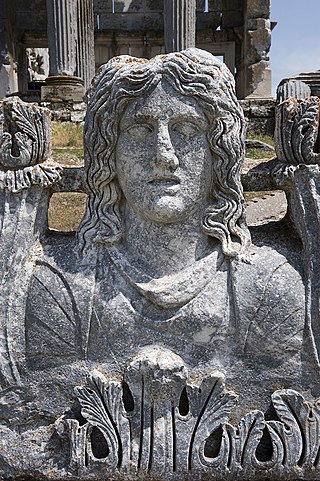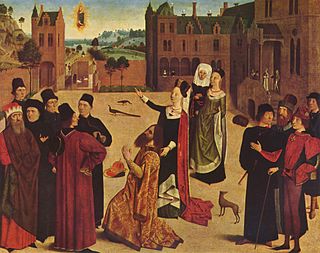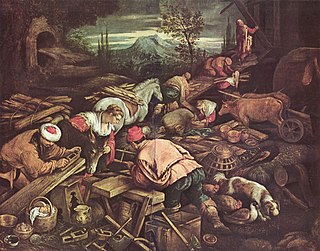
An oracle is a person or thing considered to provide insight, wise counsel or prophetic predictions, most notably including precognition of the future, inspired by deities. If done through occultic means, it is a form of divination.

The Erythraean Sibyl was the prophetess of classical antiquity presiding over the Apollonian oracle at Erythrae, a town in Ionia opposite Chios, which was built by Neleus, the son of Codrus.

The sibyls were prophetesses or oracles in Ancient Greece.

The Sibylline Oracles are a collection of oracular utterances written in Greek hexameters ascribed to the Sibyls, prophetesses who uttered divine revelations in a frenzied state. Fourteen books and eight fragments of Sibylline Oracles survive, in an edition of the 6th or 7th century AD. They are not to be confused with the original Sibylline Books of the ancient Etruscans and Romans which were burned by order of the Roman general Flavius Stilicho in the 4th century AD. Instead, the text is an "odd pastiche" of Hellenistic and Roman mythology interspersed with Jewish, Gnostic and early Christian legend.

The Tiburtine Sibyl or Albunea was a Roman sibyl, whose seat was the ancient Etruscan town of Tibur.

The Sibylline Books were a collection of oracular utterances, set out in Greek hexameter verses, that, according to tradition, were purchased from a sibyl by the last king of Rome, Lucius Tarquinius Superbus, and consulted at momentous crises through the history of the Roman Republic and the Empire.

Mount Ida is a mountain in northwestern Turkey, some 20 mi (32 km) southeast of the ruins of Troy, along the north coast of the Edremit Gulf. It is between Balıkesir Province and Çanakkale Province.

The Delphic Sibyl was a woman who was a prophet associated with early religious practices in Ancient Greece and is said to have been venerated from before the Trojan Wars as an important oracle. At that time Delphi was a place of worship for Gaia, the mother goddess connected with fertility rituals that are thought to have existed throughout the ancient Mediterranean world. As needed to maintain the religious tradition, the role of sibyl would pass to another priestess at each site.

The Persian Sibyl – also known as the Babylonian, Chaldaean, Hebrew or Egyptian Sibyl – was the prophetic priestess presiding over the Apollonian oracle.

The Cimmerian Sibyl, by name Carmentis, was the prophetic priestess presiding over the Apollonian Oracle at Cimmerium in Italy, near Lake Avernus.

The Libyan Sibyl, named Phemonoe, was the prophetic priestess presiding over the Oracle of Zeus-Ammon at Siwa Oasis in the Libyan Desert.

The Samian Sibyl was the priestess presiding over the Apollonian oracle near Hera's temple on the Isle of Samos, a Greek colony. The word Sibyl comes from the ancient Greek word sibylla, meaning prophetess. There were many Sibyls in the ancient world but she is the one who prophesied the Birth of Jesus in the stable. The Samian Sibyl, by name Phemonoe, or Phyto of whom Eratosthenes wrote.

In the extended complement of sibyls of the Gothic and Renaissance imagination, the Phrygian Sibyl was the priestess presiding over an Apollonian oracle at Phrygia, a historical kingdom in the west central part of the Anatolian highlands. She was popularly identified with Cassandra, prophetess daughter of Priam's in Homer's Iliad.

The wives aboard Noah's Ark were part of the family that survived the Deluge in the biblical Genesis flood narrative from the Bible. These wives are the wife of Noah, and the wives of each of his three sons. Although the Bible only notes the existence of these women, there are extra-biblical mentions regarding them and their names.

The Sibillini Mountains, or Sibylline Mountains are one of the major mountain groups in the Italian Peninsula, and part of the Apennines range. Most of the peaks are over 2,000 m (6,600 ft); the highest is Monte Vettore at 2,476 m (8,123 ft).

The Cumaean Sibyl was the priestess presiding over the Apollonian oracle at Cumae, a Greek colony near Naples, Italy. The word sibyl comes from the ancient Greek word sibylla, meaning prophetess. There were many sibyls throughout the ancient world. Because of the importance of the Cumaean Sibyl in the legends of early Rome as codified in Virgil's Aeneid VI, and because of her proximity to Rome, the Cumaean Sibyl became the most famous among the Romans. The Erythraean Sibyl from modern-day Turkey was famed among Greeks, as was the oldest Hellenic oracle, the Sibyl of Dodona, dating to the second millennium BC according to Herodotus, favored in the east.
Marpessos was a settlement in the middle Skamander valley of the Troad region of Anatolia. The settlement's name is also spelled Μαρμησσός, Μαρμισσός, Μερμησσός in ancient sources. It was known in Classical antiquity primarily as the birthplace of the Hellespontine Sibyl Herophile. Its site has been located at Dam Dere approximately 2 km SE of the village of Zerdalilik in the Bayramiç district of Çanakkale Province in Turkey. Despite the similarity of its name and its location on Mount Ida, the settlement is apparently unrelated to the mythological figure Marpessa and her husband Idas. It should likewise not be confused with the Mount Marpessa on Paros.

Eclogue4, also known as the FourthEclogue, is a Latin poem by the Roman poet Virgil. The poem is dated to 40 BC by its mention of the consulship of Virgil's patron Gaius Asinius Pollio.

Prophetiae Sibyllarum are a series of twelve motets by the Franco-Flemish composer Orlande de Lassus. The works are known for their extremely chromatic idiom.

The Arabic Sibylline prophecy is a set of Christian apocalyptic texts based on the tradition of the Tiburtine Sibyl. The original version of the prophecy was probably composed in the late 8th century by Melkites in ʿAbbāsid Syria. It is an example of vaticinia ex eventu and was composed "to give encouragement and hope to Christians living under Islamic rule, especially during periods of political instability." The prophecy is possibly the oldest apocalyptic text composed in Arabic.




















